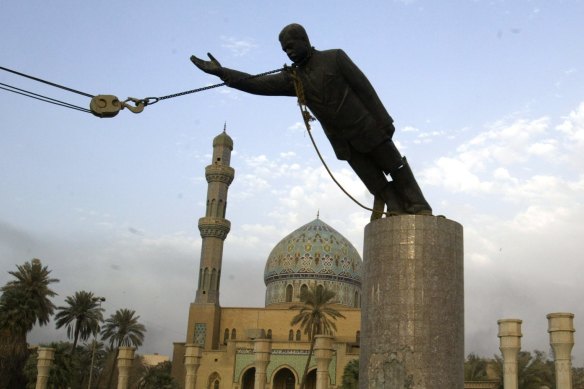Crypto’s future could look like Iraq’s past
The Iraqi dinar was ahead of its time. Years before Bitcoin was invented, day traders were lured by the viral economic narrative that the Iraqi currency was a ticket to retirement riches following Saddam Hussein’s downfall.
Economists and regulators warned it was a gamble, but punters still paid high fees to own an illiquid currency that some thought might just become the most valuable in the world. Instead, it was devalued by 20 per cent in 2020.
The dinar is on economists’ minds again as the cryptocurrency market reels from its latest crash — with $US2 trillion ($3 trillion) of value wiped off a market rife with fraud, theft and high-profile corporate collapses including FTX and BlockFi.

Years before Bitcoin was invented, day traders were lured by the narrative that the Iraqi currency was a ticket to riches following Saddam Hussein’s downfall.Credit:Jerome Delay
The parallels aren’t just about laser-eyed speculation, but the dinar’s historical development as a medium of exchange. While optimists such as investor Bill Ackman see crypto making a comeback if the right technological use case comes along, Iraq’s experience suggests that the survival of any form of money depends more on faith in the institutions backing it.
Back in the 1990s, after the First Gulf War, there were effectively two Iraqs: A south controlled by Saddam, and a north that was essentially a Kurdish protectorate backed by a no-fly zone. As a result, the dinar branched into two paths.
In the south, Saddam embarked on money-printing to prop up an economy struggling under sanctions. New banknotes bearing his image, called “Saddam” or “print” dinar, were produced locally to poor standard. Inflation soared to an average of 250 per cent between 1991-1995 as the circulating money supply ballooned, former Bank of England boss Mervyn King noted in a 2004 speech.
In the north, where the new dinar didn’t circulate and where bank cash wasn’t expropriated by the Saddam regime, the old “Swiss” dinar — so-called because it was printed on plates manufactured in Switzerland – continued to be used. It lasted right up until Saddam’s fall, despite having no central bank or government giving it value.
The relevance for crypto is that faith in the long-term value of its multitude of tokens might depend on the existence of credible institutions, something it increasingly lacks.
Having two fiat currencies in the same country was obviously a surprising development. That the Swiss dinar kept going and rose in implied value relative to its sibling is maybe not so remarkable given the scale of currency mismanagement taking place in the south.
For all the latest Business News Click Here
For the latest news and updates, follow us on Google News.
